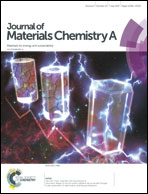N,S co-doped 3D mesoporous carbon–Co3Si2O5(OH)4 architectures for high-performance flexible pseudo-solid-state supercapacitors†
Abstract
Ultrathin Co2Si2O5(OH)4 flakes were grown on mesoporous carbon frameworks via two simple steps of calcination and hydrothermal treatment with natural bamboo leaves as the renewable silica source. More importantly, the existence of carbon frameworks co-doped with nitrogen and sulfur could offer large specific capacitance due to their possible faradaic reactions. The combination of porous carbon frameworks derived from natural bamboo leaves and the layer structures of silicate leads to plentiful ion channels. These possible reasons made the materials show a high performance as supercapacitor electrode materials when tested in 3.0 M aqueous KOH solution with a three-electrode system. In 3.0 M KOH solution, the specific capacitance of the electrode is 1600 F g−1 under the current density of 1.0 A g−1. The as-assembled pseudo-solid state device also showed a high specific capacitance of 352 mF cm−2 under a current density of 1.0 mA cm−2, and retained about 97.2% of the initial capacity after 6000 cycles. Moreover, it exhibited excellent mechanical flexibility when bending the device at different angles, and even after 1000 cycles the specific capacitance was stable. The long cycle life and high specific capacitance of the ultrathin flakes made them a great potential candidate for supercapacitor electrodes.



 Please wait while we load your content...
Please wait while we load your content...